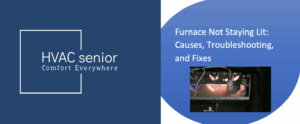A warm RV can be just the thing to make cool nights on the road bearable. But when the furnace in an RV stops working-won’t light, won’t blow hot air, or simply just keeps shutting off-it can take an adventure and turn it into a freezing nightmare.
The good news? Most RV furnace problems are common and fixable, if you understand how the system works and what to check first.
This RV furnace troubleshooting guide will walk you through:
- How an RV furnace works
- The most common problems
- Step-by-step diagnostics
- Safety tips and maintenance advice
Whether you’re using a Suburban, Atwood, or Dometic RV furnace, these tips will help you restore heat quickly and safely.
Also read: Furnace Leaking Water when AC is Off.
How an RV Furnace Works
Most RV furnaces use propane gas and 12-volt electricity to heat your vehicle. Here’s the basic process.
- The thermostat senses the temperature and sends a signal to the furnace.
- The blower motor begins its operation by removing residual gas.
- The ignition system (pilot light or electronic igniter) ignites the burner.
- Hot air moves through ducts or vents, warming your RV.
- The system will automatically shut off when the set temperature is reached.
If any of these steps fail, then your RV furnace will fail to run.
Common Problems and Fixes in RV Furnaces
Here’s a list of the most common problems RVers encounter — and how to troubleshoot each one.
1. RV Furnace Won’t Turn On
Possible Causes:
- Blown fuse or tripped breaker
- Dead batteries (low 12V power)
- Faulty thermostat or loose wiring
Fixed:
- Check for blown fuses in your RV’s main fuse box and replace them.
- Check that your house batteries are charged — most furnaces won’t start if voltage is below 10.5–11 volts.
- Test your thermostat by either turning it off and then back on, or temporarily bypassing it to see if the furnace starts.
- Inspect all wiring connections for corrosion or looseness.
2. RV Furnace Fan Runs But No Heat
Possible Causes:
- Low propane pressure
- Dirty or clogged burner
- Ignition system failure
- Faulty sail switch
Fixes:
- Make sure that your propane tank is full and the valve is open.
- Clean the burner assembly; a carbon buildup can prevent ignition.
- Check the igniter electrode for any cracks or dirt.
- Test the sail switch; this device assures proper airflow before ignition. A defective or stuck sail switch won’t allow the furnace to light.
Pro Tip:
If the fan runs for 30 seconds but there’s no flame or heat, suspect the ignition system or propane flow.
3. Furnace Blows Cold Air
Possible Causes:
- Airflow limitation
- Dirty air filter or blocked vents
- Failing thermostat or control board
Fix:
- Clean or replace your air filter.
- Check for blocked vents-ensure that furniture or storage containers are not blocking air flow.
- Check for voltage signals at the control board and thermostat by using a multimeter.
- If everything checks out and air is still cold, then your burner is probably not lighting fully.
4. Furnace Lights Up Then Turns Off
Possible Causes:
- Faulty flame sensor
- Clogged exhaust or intake vent
- Faulty limit switch
Correctness:
- Remove and clean the flame sensor with a soft cloth or fine sandpaper.
- Check the outside vents-mud daubers, wasps, or dirt may be obstructing the airflow.
- Inspect the limit switch (which protects against overheating). If defective, replace it.
Tip:
If the furnace lights but then turns off after 10 seconds, the problem is usually with the flame sensor or limit switch.
5. Furnace Making Loud or Strange Noises
Possible Causes:
- Debris in the blower fan
- Loose mounting bolts
- Worn motor bearings
Fix:
- Turn off the power and propane. Take out the access panel and clean the blower wheel.
- Tighten loose bolts and brackets.
- Lubricate or replace the blower motor if noise persists.
A loud or vibrating furnace may also be indicative of problems with the air ducts themselves-disconnects or kinked ducts, for example.
6. Furnace Clicks But Doesn’t Ignite
Possible Causes:
- No propane reaching the burner
- Faulty gas valve or igniter
- Dirty combustion chamber
Solution:
- Check propane pressure and line condition.
- Clean the burner orifice with compressed air.
- Check and test the gas valve, which should click open during ignition.
- Replace the igniter if it’s cracked or weak.
7. Furnace Runs Intermittently
Possible Causes:
- Overheating due to poor ventilation
- Faulty thermostat sensor
- Dirty fan or ducts
Fix:
- Return air vents should not be blocked.
- Clean all furnace components and ducts.
- Replace or recalibrate the thermostat sensor if the readings are wrong.
Also read: Furnace Blower Motor Not Working
Safety Tips When Troubleshooting an RV Furnace
Working with propane and electricity requires care. Follow these safety precautions:
- Always turn power and propane off before removing access panels.
- Never override safety switches: sail, limit, or flame sensors.
- Use a CO detector inside your RV: carbon monoxide leaks are dangerous.
- If you smell gas, shut off propane immediately and ventilate the RV.
- Gas valve or ignition system repairs should be done by a licensed RV or HVAC technician.
Maintenance Tips to Prevent Furnace Problems
Regular maintenance helps keep your RV furnace running reliably and quietly all season long.
Monthly or Before Each Trip
- Clean air intake and exhaust vents
- Check propane tank levels and connections
- Inspect thermostat operation
- Test CO and propane detectors
Wash every 6 months
- Remove and clean blower fan and burner area
- Wiring and connector inspection
- Check sail and limit switches for dust or corrosion
Annually
- Have your furnace professionally serviced and inspected in its entirety.
- Replace worn belts or motors if necessary.
- Pressure-test the propane lines for leaks
Common RV Furnace Error Codes
Many modern furnaces such as Atwood or Suburban models flash code LEDs on control boards.
Here’s what some mean:
| Flash Code | Meaning | Possible Fix |
| 2 flashes | Ignition failure | Check igniter and propane pressure |
| 3 flashes | Limit or airflow fault | Clean vents and blower |
| 4 flashes | Low voltage | Recharge or replace batteries |
| 5 flashes | Flame sense error | Clean flame sensor |
Refer to your furnace’s manual for brand-specific codes.
Also read: Furnace Pressure Switch Stuck Open
When to Call a Professional
If, with the basics checked and your furnace still won’t run properly, it is time to call a certified technician, especially if:
- You smell propane or hear a hissing sound
- Furnace continually turns on and off
- Blower motor does not turn
- You suspect a control board or gas valve failure
A professional can test for gas pressure, sensors, and wiring with special tools to diagnose safely.
Estimated Repair Costs for RV Furnaces
| Problem | Typical Cost (USD) |
| Replace thermostat | $100 – $200 |
| Replace sail or limit switch | $80 – $150 |
| Clean burners and blower | $100 – $250 |
| Replace blower motor | $250 – $600 |
| Replace circuit/control board | $300 – $700 |
| Replace entire furnace | $900 – $2,000 |
Conclusion
If you find yourself asking, “Why is my RV furnace not working?”, the common culprits usually revolve around airflow, ignition, or propane delivery problems. This RV furnace troubleshooting guide will help you identify most of the problems, perform safe DIY fixes, and know when to call a pro. Properly maintained, with a clean vent and charged batteries, your RV furnace will keep you warm, efficient, and comfortable no matter where the road takes you.















